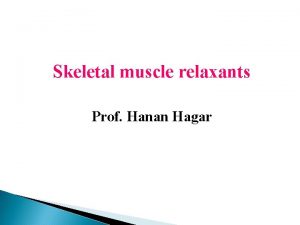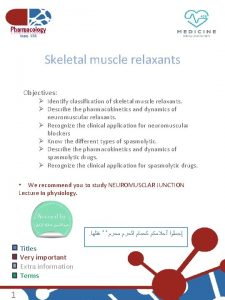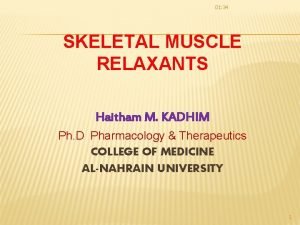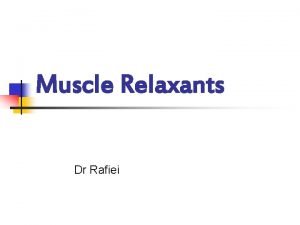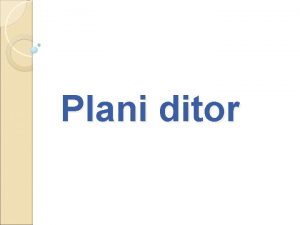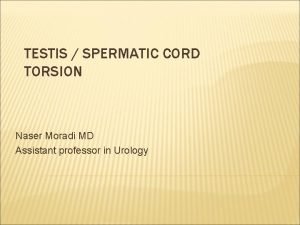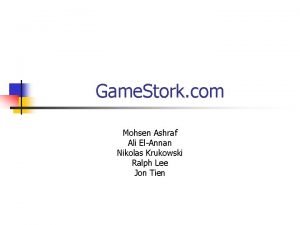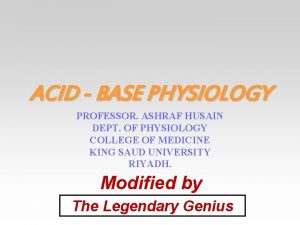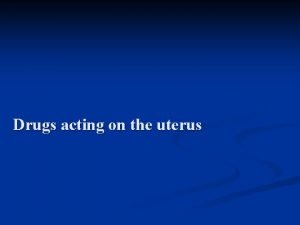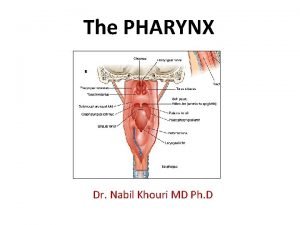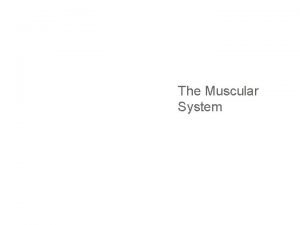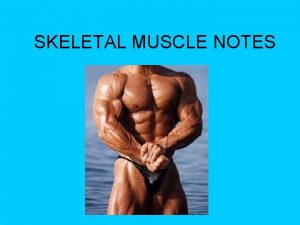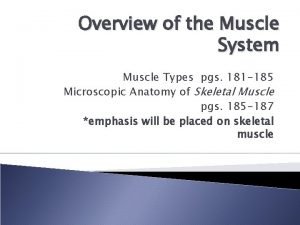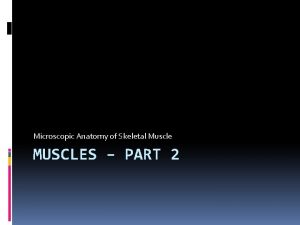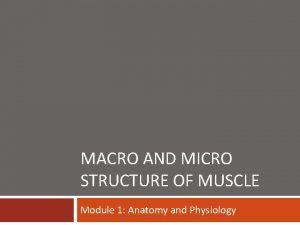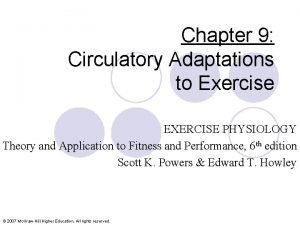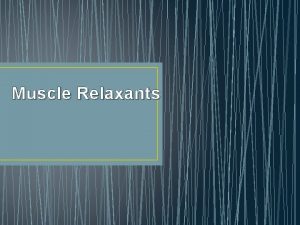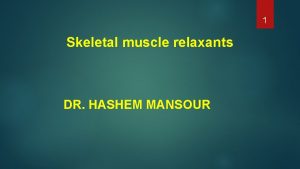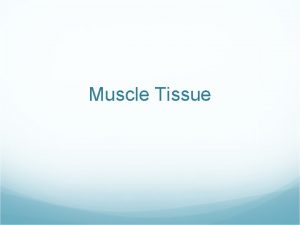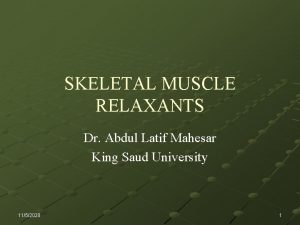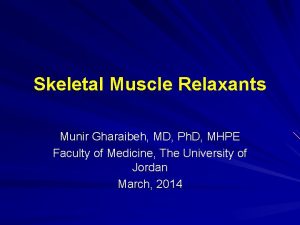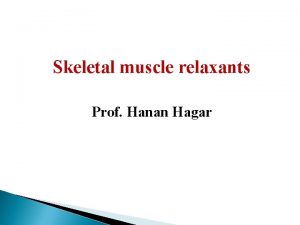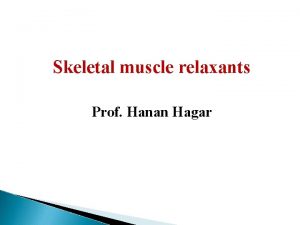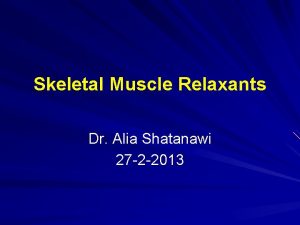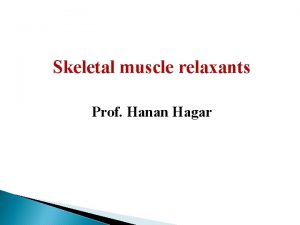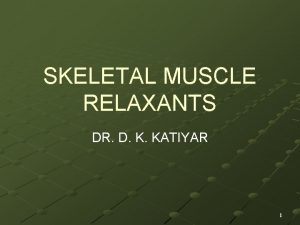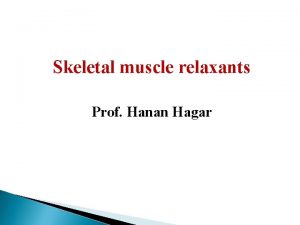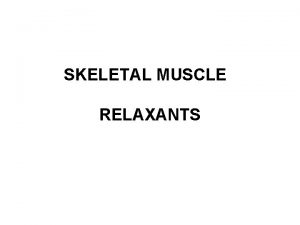Skeletal Muscle Relaxants Dr Naser Ashraf Types of


























- Slides: 26

Skeletal Muscle Relaxants Dr Naser Ashraf

Types of skeletal muscle relaxants: 2 groups • Neuromuscular blockers • Relax normal muscles (surgery and assistance of ventilation) • No central nervous system activity. • Used primarily as a part of general anesthesia • Spasmolytics • Reduce spasticity • Centrally acting (except dantrolene which act on the skeletal muscle) • Used in a variety of neurologic conditions

Skeletal Muscle Relaxants Neuromuscular blockers Spasmolytics Non-depolarizing (Competitive) • D tubocurarine • Pancuronium • Vecuronium • Diazepam • Atracurium • Chlorzoxazone • Mivacurium • Tizanidine • Baclofen Depolarizing (Non-Competitive) • Succinylcholine • Decamethomium Directly acting Centrally acting • Dantrolene

Skeletal Muscle contraction Na+ Na + tio n ab 2+ a Ca Ac ACH Po ten tia l ACH b a NMreceptor a Motor neuron ACH ACH ACH a ba Skeletal Muscle ACHEsterase

Mechanism of action of Neuromuscular Blockers

Normal d-Tubocurarine A Ch Ach Ach Repolarizatio n Contraction Relaxation SCh Ach Depolarizatio n Succinylcholine No Depolarization No contraction Flaccid Paralysis Persistent Depolarization Contraction (Fasciculati on) Relaxation

Competitive Antagonists (Non-depolarizing Blockers)

(Non-depolarizing blockers) • Long-acting: d tubocurarine, pancuronium • Intermediate: Atracurium , vecuronium , rocuronium , • Short-acting: Mivacurium

Anti-cholinestrases (neostigmine, edrophonium) which preserve acetylcholine are used to reverse the effect of d-tubocurarine Mechanism of Action Competitive Antagonism Agonist Ach Antagonist d-Tubocurarine Affinity : Yes Intrinsic action : No NM receptor Motor End Plate

Actions • Muscle weakness Flaccid paralysis • Order of muscle affected: – – – – Extrinsic eye muscles, muscles of finger Neck muscles (muscles of phonation and swallowing) Face Hands, Feet Trunk Respiratory muscles (intercostal and diaphragm) • Recovery in the reverse order • Consciousness, appreciation of pain not affected

Actions • Autonomic ganglion blocking property • Histamine release (by d-tubocurarine) • CVS – Significant fall in BP – Increase in Heart rate – Vagal gangionic blockade (also ‘ve’ and ‘pan’) • Newer competitive blockers: – Negligible effect on BP and HR

Adverse effects • • • Hypotension Tachycardia Respiratory paralysis Bronchospasm Aspiration of gastric contents

Advantages of synthetic (Newer) competitive blockers • • • Less histamine release Do not block autonomic ganglia Spontaneous recovery with most of drugs Rapacuronium & rocuronium have rapid onset Atracuronium: Hoffmans elimination Mivacurium short acting

Uses • As an adjunct to general anaesthesia – For producing satisfactory skeletal muscle relaxation • For facilitating endotracheal intubation – Rocuronium preferred due to rapid onset of action – Succinylcholine is better due to short lasting duration

Depolarizing Blocker (Non-competitive Antagonist) Succinylcholine One Drug, Two blocks, Brief and quick, Genetic variability in metabolism, Malignant hyperthermia

Skeletal Muscle Relaxants Quaternary ammonium Succinyl Choline Depolarising muscle relaxants Two molecules of Acetylcholine) Acetylcholine Quaternary ammonium

Mechanism of action Agonist at Nicotinic (NM) receptor Produces neuromuscular block by overstimulation, end plate is unable to respond to further stimulation. Longer lasting or persistent depolarization

Succinylcholine Actions • Small rapidly moving muscles (eye, jaw, larynx) relax before those of limbs and trunks • Ultimately intercostals and finally diaphragm paralysis occur respiratory paralysis • Recovery in the reverse order • Muscle relaxation: Onset: within 1 min; peak: 2 min, duration: 5 min; longer duration relaxation requires continued IV infusion

Succinylcholine Uses Suitable for short-term procedures • Rapid endotracheal intubation during induction of anaesthesia • During Electro-Convulsive shock Therapy (ECT) – To prevent injury

Succinylcholine Adverse Effects • Transient Intraocular Tension • Hyperkalemia : Fasciculations release potassium in blood • Succinylcholine apnoea • Malignant hyperthermia: when used alng with halothane in general anaesthesia – Treatment is by rapid cooling of patient & dantrolene i. v • Muscle pain

Treatment of succinylcholine apnoea • No antidote is available • Fresh frozen plasma should be infused • Patient should be ventilated artificially untill full recovery

Comparison of Competitive and Depolarizing Blocking Agents Sr. no Competitive Succinyl choline 1 Competitive blockade Persistant depolarization 2 Non depolarizing Depolarizing 3 Single block Dual block 4 Anticholinesterases reverse blockade Do not reverse 5 Initial fasciculations not Present present 6 Slow onset long duration Rapid onset short duration 7 Release histamine Doesn’t release

Dantrolene • Directly acting skeletal Muscle relaxant • Inhibits depolarization induced calcium release from sarcoplasmic reticulum by acting on ryanodine receptors • Drug of choice in malignant hyperthermia

Drug interactions • Non depolarizing blockers – Anticholine-esterases (Neostigmine) • Reverse the action of only non depolarizing blockers – Halothane, Aminoglycoside antibiotic like gentamicin & calcium channel blockers like nifedipine • Enhances the neuromuscular blockade • Depolarizing blockers – Halothane can cause malignant hyperthermia

Ganglion blockers • Competitive blockers • Persistant depolarizing – Hexamethonium – Trimethaphan – Mecamylamine – Nicotine large dose

Actions & Adverse effects of ganglion blockers S. No Organ Dominant ANS Effect/(side effect)of ganglionic blockade 1. Heart Parasympathetic Tachycardia (Palpitations) 2. Blood vessels Sympathetic Vasodilation (Hypotension) 3. Iris Parasympathetic Mydriasis (Photophobia) 4. Ciliary Muscle Parasympathetic Cycloplegia (Blurring of vision) 5. Intestines Parasympathetic ↓ motility (Constipation) 6. Bladder Parasympathetic ↓ tone (difficulty in micturation) 7. Male sexual function Parasympathetic Inhibition of erection & ejaculation (Impotence) 8. Salivary Glands Parasympathetic Inhibition of salivation (dry mouth, difficulty in swallowing) 9. Sweat Glands Sympathetic Inhibition of sweating
 Centrally acting skeletal muscle relaxants
Centrally acting skeletal muscle relaxants Skeletal muscle relaxants classification
Skeletal muscle relaxants classification Skeletal muscle relaxants classification
Skeletal muscle relaxants classification Skeletal muscle relaxants classification
Skeletal muscle relaxants classification Skeletal muscle relaxants classification
Skeletal muscle relaxants classification Non depolarizing muscle relaxant classification
Non depolarizing muscle relaxant classification Muscle relaxant classification
Muscle relaxant classification Smooth muscle contraction
Smooth muscle contraction Plani ditor gjuhe shqipe
Plani ditor gjuhe shqipe Dr bobby hery yudhanto
Dr bobby hery yudhanto Jack warecki
Jack warecki Dr tariq ashraf
Dr tariq ashraf Mohsen ashraf
Mohsen ashraf Ashraf husain
Ashraf husain Ashraf husain
Ashraf husain Conistipation
Conistipation Operation nickel grass
Operation nickel grass Uterine stimulants and relaxants
Uterine stimulants and relaxants Tonsil blood supply
Tonsil blood supply Label the superficial muscles
Label the superficial muscles Epi endo peri
Epi endo peri Comparison of skeletal cardiac and smooth muscle
Comparison of skeletal cardiac and smooth muscle Cardiac skeletal and smooth muscle comparison
Cardiac skeletal and smooth muscle comparison Microscopic anatomy of skeletal muscles
Microscopic anatomy of skeletal muscles Macro structure of muscle
Macro structure of muscle Organisation of skeletal muscle
Organisation of skeletal muscle Skeletal muscle pump
Skeletal muscle pump
